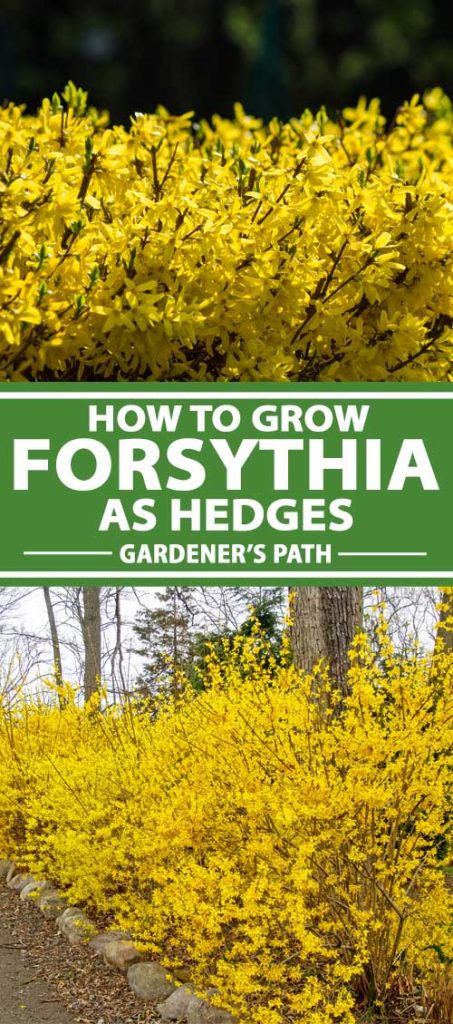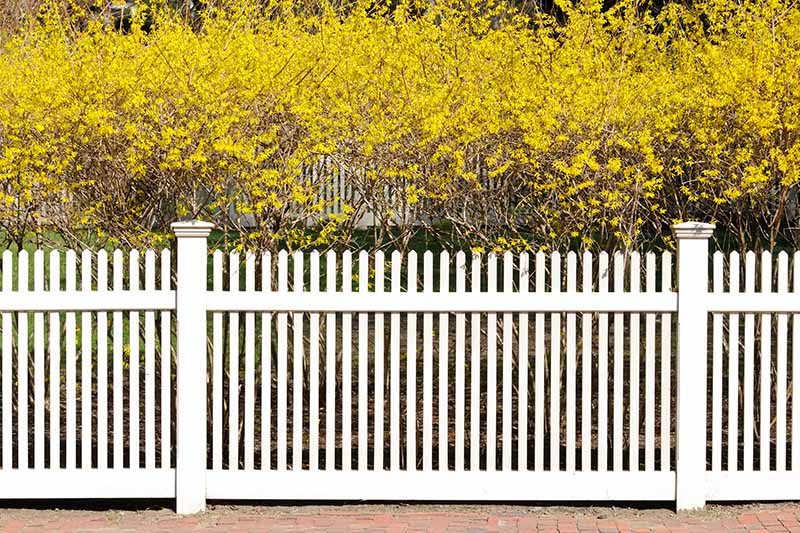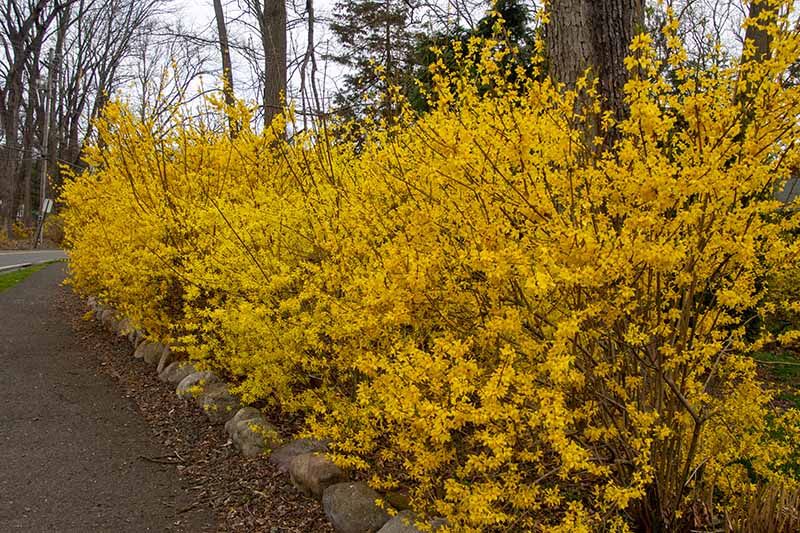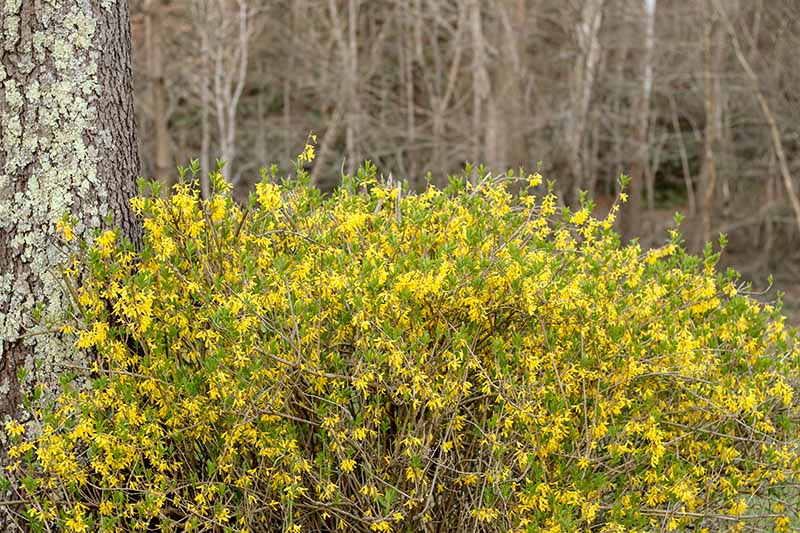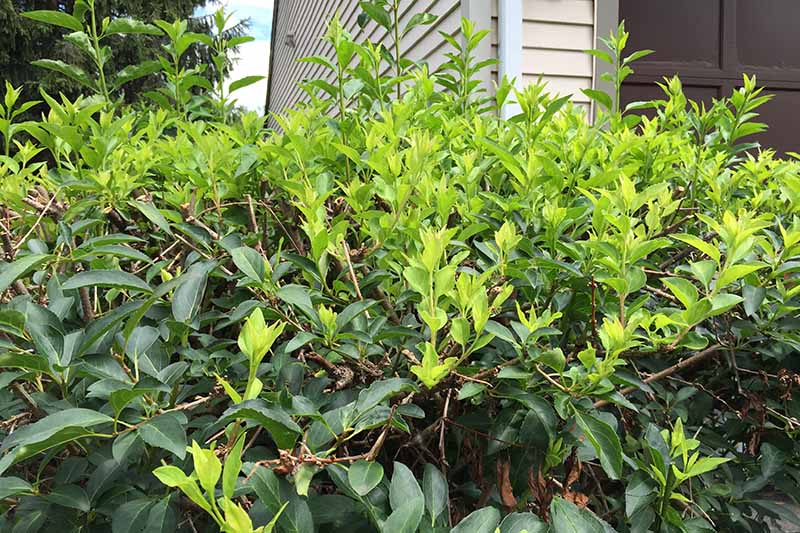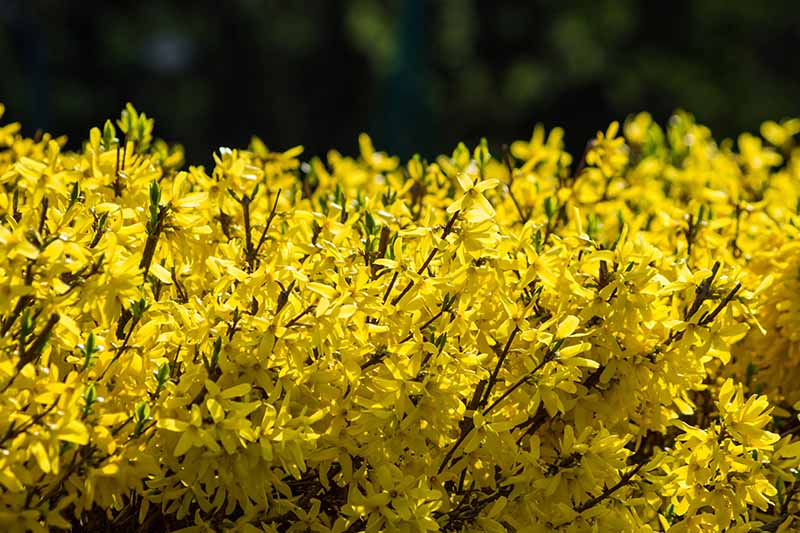In our forsythia growing guide, we discuss all you need to know to cultivate this sun-loving, vigorous shrub in your landscape. We link to vendors to help you find relevant products. If you buy from one of our links, we may earn a commission. When shopping for plants, be sure to evaluate the unique qualities of each and how they can fill your gardening needs.
A Versatile Shrub
Forsythia is a versatile shrub. It makes a lovely specimen plant, on an island of its own, with perhaps a few spring bulbs at its feet. However, it is capable of much more than standing about looking pretty.
Plant several together, or in a mixed planting with other shrubs, and they have the power to perform vital garden functions such as marking a property perimeter, walling in a secluded garden room, blocking an undesirable view, or shielding a portion of your outdoor space from onlookers. Easy to establish, cold-hardy forsythia is a real workhorse in the landscape. It’s drought and salt tolerant and it grows fast, often two feet or more per year, depending upon the variety. And while some bushes – like the less desirable forms of privet – are prolific self-sowers, forsythia seed has a poor germination rate, so you are unlikely to find unwanted little seedlings scattered about. Forsythia certainly makes the grade when it comes being reliable. With forethought and proper care, you can rest assured that it will serve you well.
7 Tips for Growing a Forsythia Hedge
As you begin to explore the best ways to use forsythia as a hedge in your landscape, you’ll need to ask yourself some important questions, and consider the level of maintenance you are willing to take on. The following tips will get you off to a good start:
1. Choose the Right Variety
There are 11 species of forsythia. Three you are very likely to encounter are: F. suspensa, a 6- to 10-foot-tall plant with weeping branches that may be trained as a vine or allowed to creep and take root as a ground cover. F. viridissima, aka greenstem, a compact upright type that tops out at 10 feet tall. F. x intermedia, a hybrid cross of F. suspensa and F. viridissima with both arching and upright branches, and a mature height of 8 to 10 feet.
There are numerous cultivars of the various species, and each has its pros and cons. For example, F. intermedia ‘Spectabilis’ is prized for being a prolific bloomer. However, its branches are not as dense as some types, which makes it an inferior choice for a privacy screen. As you formulate your hedge-growing goals, pay particular attention to the mature sizes and desirable traits of available selections, and make your decision accordingly. You wouldn’t want to plan for a two-foot-tall pathway hedge, only to find yourself with a large variety that puts on two to four feet of new growth each year! In addition, to mix shrubs in your hedge, be sure to choose plants with similar cultural requirements and mature heights.
2. Commit to a Formal or Informal Style
You’ll need to decide if you want loose, trailing canes; dense, upright ones; or a combination of arching and upright.
This decision depends on various factors such as the function you require, style you prefer, and the amount of space you have available. Varieties with loose, trailing canes are best grown informally, so they can showcase their natural grace. Pruning them into unnatural shapes is neither desirable nor necessary, with upright varieties available. Dwarf types provide a friendly way to divide properties, but still bring neighbors together to chat. They grow in a compact, upright fashion. Let them take a natural shape, or prune them into a boxy or rounded hedge. Tall, compact, upright varieties are useful for blocking unwanted views with their flowers in spring, leaves in summer and fall, and dense branches in winter. Large bushes that have weeping branches, or a combination of arching and upright, are best grown informally. It is counterproductive to battle two to four feet of growth each year with pruning shears, in an attempt to make them behave contrary to their nature. Medium-sized varieties with an upright growth habit are especially useful in mixed hedges of medium height that include an eclectic variety of bushes with similar cultural requirements. And medium-sized forsythia with a tendency to arch, or to be both arched and upright, make wonderful informal hedges where they have room to spread in various directions at will.
3. How to Plant
Decide where you want your hedge and measure the distance from end to end. Allow enough space for mature widths, plus one to two feet between small shrubs, four to six between medium-sized ones, and eight to ten between the largest.
Decide how far apart they should be placed, based on the above guidance, and dig one long trench. It needs to be as wide as the space you require between each shrub. For example, if you are planting medium-sized shrubs that require four to six feet between them, be sure that your trench is four to six feet wide. Starting at one end of the trench, place the shrubs as recommended, but not in a straight line. Instead, stagger them in a zig-zag form, so that one is up and the next one is down, with the proper space between them. This pattern allows them to intertwine well and form a dense thicket. If you are aiming for an informal style, you may choose different cultivars, but they should be of a similar size at maturity to avoid casting shade on one another. For a formal hedge, use one type of plant so they grow at the same rate and have a uniform appearance. After planting, prune as needed so that all plants start out at about six inches tall and grow up together.
4. Grow in Baby Steps
As your new shrubs become established, you’ll soon be thrilled by that first flush of growth that sends new canes up two feet or more. Here’s where the discipline begins. To train your shrubs into a formal hedge, you’ll need to begin pruning with that first flush of new growth. A general rule of thumb is to cut six inches off every time there’s a new foot of growth. Prune just above a set of leaves, in order to promote even branching from the bottom up. This means you’ll need to prune several times during the growing season, as opposed to once just after blooming. Be aware that you may have few to no flowers while your plants grow to the desired height. If you were to allow the tall canes to remain on the plant and just nip the tops off at the desired height, you would likely end up with a narrow base and a wide top. The next tip explains why this is not a good shape to encourage.
5. Let the Sun Shine In
If you choose to manicure your hedges into a boxy or rounded shape, you’ll need to keep in mind that all parts of the shrub need to receive sunlight in order to thrive.
Therefore, when you choose a shape, make sure that as you prune, you angle your shears so that the bottom of the plant is wider or as wide as the side and top. If you prune in such a way that the bottom of the shrub is narrower than the side and top, the bottom part is sure to die off – revealing unsightly bare stems with neither flowers nor leaves. Similarly, shrubs that grow beneath trees and in the shade of buildings may not receive the full sun they require, resulting in a poor showing of flowers, and leaves that are sparse or pale.
6. How to Prune
Formal and informal hedges benefit from routine pruning to remove dead branches, open up their middles to more sunlight and airflow, maintain a desired shape or reduce unwanted volume. The right time to prune your forsythia is as soon as the flowers drop off. This is because it begins to set next year’s buds almost immediately after blooming. The challenge is that the leaves usually come out before the flowers are all gone, making it hard to see the “bones” of the shrub. However, with growth of two feet or more per year, manicured shrubs require annual pruning to maintain the desired shape and size. It is tempting to prune them twice during the growing season, once just after blooming and again during the summer. However, by doing this you risk cutting off next year’s flower buds, resulting in few to no blooms. The solution for formal shrubs is to prune once as described, but to go shorter than the desired height to allow for more growth during the summer months. How much shorter? The general rule of thumb for pruning shrubs is to take off no more than one-third of a shrub at one time. However, forsythia is a unique case because of the early bud set, so you may have to go a bit shorter to stay ahead of vigorous growth. Read more forsythia pruning tips here.
7. Periodic Deep Pruning
All types of forsythia, regardless of growth style, need a deep pruning every three years or so, because the middle branches tend to die as they get older. In addition, these shrubs have a tendency to grow low branches that root readily. Trim them off for a neater appearance. Read more about deep pruning forsythia for rejuvenation.
Familiar, Yet Exceptional
Fast-growing, cold hardy, and drought and salt tolerant, you can’t go wrong with hardworking forsythia on the job in your outdoor living space.
And with seven tips for success, you can rest assured that your vision will become a reality. I’ve long used forsythia to establish property boundaries, because it is so easy to propagate from soft stem cuttings or by layering. In addition, I rarely have to water it, and it isn’t adversely affected by road salt churned up by passing vehicles in winter. However, some folks pooh-pooh this shrub. It’s not native to the United States, although it has naturalized to the point that most people think it is. And because it’s everywhere here in the Northeast, many consider it to be too ordinary and almost weed-like. I beg to differ. It heralds spring for my loved ones and me, and has been the backdrop of holiday photos for several generations. Its brilliant blooms never fail to provide a feeling of continuity and well-being.
Are you ready to add hedges to your landscape with the attractive forms and versatile functions of forsythia? If you currently grow these golden beauties, feel free to share your experience in the comments section below. For more information on growing forsythia shrubs in your garden, you’ll need these guides next:
How to Care for Cold-Damaged Forsythia How to Manage Forsythia Gall Disease 5 Common Causes of Forsythia Yellowing
© Ask the Experts, LLC. ALL RIGHTS RESERVED. See our TOS for more details. Uncredited photos: Shutterstock.
